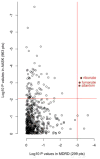Serum metabolites are associated with all-cause mortality in chronic kidney disease
- PMID: 29871777
- PMCID: PMC6054894
- DOI: 10.1016/j.kint.2018.03.008
Serum metabolites are associated with all-cause mortality in chronic kidney disease
Abstract
Chronic kidney disease (CKD) involves significant metabolic abnormalities and has a high mortality rate. Because the levels of serum metabolites in patients with CKD might provide insight into subclinical disease states and risk for future mortality, we determined which serum metabolites reproducibly associate with mortality in CKD using a discovery and replication design. Metabolite levels were quantified via untargeted liquid chromatography and mass spectroscopy from serum samples of 299 patients with CKD in the Modification of Diet in Renal Disease (MDRD) study as a discovery cohort. Six among 622 metabolites were significantly associated with mortality over a median follow-up of 17 years after adjustment for demographic and clinical covariates, including urine protein and measured glomerular filtration rate. We then replicated associations with mortality in 963 patients with CKD from the African American Study of Kidney Disease and Hypertension (AASK) cohort over a median follow-up of ten years. Three of the six metabolites identified in the MDRD cohort replicated in the AASK cohort: fumarate, allantoin, and ribonate, belonging to energy, nucleotide, and carbohydrate pathways, respectively. Point estimates were similar in both studies and in meta-analysis (adjusted hazard ratios 1.63, 1.59, and 1.61, respectively, per doubling of the metabolite). Thus, selected serum metabolites were reproducibly associated with long-term mortality in CKD beyond markers of kidney function in two well characterized cohorts, providing targets for investigation.
Keywords: chronic kidney disease; metabolomics; mortality; uremic toxins.
Copyright © 2018 International Society of Nephrology. Published by Elsevier Inc. All rights reserved.
Conflict of interest statement
No authors have conflicts of interest. Assay costs were discounted as part of a collaboration agreement between Metabolon and JC, LI, AL to develop metabolomics estimates of GFR and for which a provisional patent has been filed 8/15/2014: PCT/US2015/044567.
Figures




Comment in
-
Crossroads of metabolism and CKD.Kidney Int. 2018 Aug;94(2):242-243. doi: 10.1016/j.kint.2018.03.023. Kidney Int. 2018. PMID: 30031444
References
-
- Hu J-R, Coresh J. The public health dimension of chronic kidney disease: what we have learnt over the past decade. Nephrol Dial Transplant. 2017;32:ii113–ii120. - PubMed
-
- van de Poll MCG, Soeters PB, Deutz NEP, et al. Renal metabolism of amino acids: its role in interorgan amino acid exchange. Am J Clin Nutr. 2004;79:185–197. - PubMed
-
- Cibulka R, Racek J. Metabolic disorders in patients with chronic kidney failure. Physiol Res. 2007;56:697. - PubMed
Publication types
MeSH terms
Substances
Grants and funding
LinkOut - more resources
Full Text Sources
Other Literature Sources
Medical

